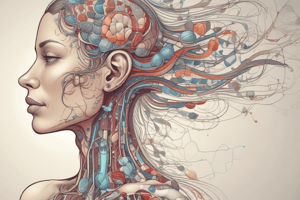Podcast
Questions and Answers
Thyroid gland is a __________-shaped gland located in the lower anterior part of the neck
Thyroid gland is a __________-shaped gland located in the lower anterior part of the neck
butterfly
The thyroid gland has __ lobes, one on either side of the trachea, just below the larynx
The thyroid gland has __ lobes, one on either side of the trachea, just below the larynx
2
__________ cells are responsible for the synthesis and storage of T3 and T4 hormones
__________ cells are responsible for the synthesis and storage of T3 and T4 hormones
Follicular
The Hypothalamic-Pituitary-Thyroid Axis regulates the production of __________ hormones
The Hypothalamic-Pituitary-Thyroid Axis regulates the production of __________ hormones
TRH is released by the __________
TRH is released by the __________
TSH binds to __________ cells in the thyroid gland, stimulating the synthesis of T3 and T4
TSH binds to __________ cells in the thyroid gland, stimulating the synthesis of T3 and T4
Albumin transports ______ of T4 and T3
Albumin transports ______ of T4 and T3
T3 has lower affinity to TBG than ______
T3 has lower affinity to TBG than ______
Calcitonin is synthesized by parafollicular C cells of the ______ gland
Calcitonin is synthesized by parafollicular C cells of the ______ gland
Calcitonin inhibits ______ resorption
Calcitonin inhibits ______ resorption
Procalcitonin is an acute phase reactant and indicates presence of systemic ______ conditions
Procalcitonin is an acute phase reactant and indicates presence of systemic ______ conditions
Free T4 & TSH are the BEST indicators of ______ status
Free T4 & TSH are the BEST indicators of ______ status
Tanned Erythrocyte Hemagglutination is a measure of anti-Tg ______
Tanned Erythrocyte Hemagglutination is a measure of anti-Tg ______
Thyrotropin-Releasing Hormone Stimulation measures the relationship between TRH and TSH secretions and is used to differentiate euthyroid & ______ patients
Thyrotropin-Releasing Hormone Stimulation measures the relationship between TRH and TSH secretions and is used to differentiate euthyroid & ______ patients
Thyroid-Stimulating Hormone is the most important thyroid function test and is the best method for detecting clinically significant thyroid ______
Thyroid-Stimulating Hormone is the most important thyroid function test and is the best method for detecting clinically significant thyroid ______
Reverse T3 is formed by the removal of one iodine ring of T4 and is a biologically inactive metabolite of ______
Reverse T3 is formed by the removal of one iodine ring of T4 and is a biologically inactive metabolite of ______
Free T4 is the biologically active fraction of T4 in plasma and is used to differentiate drug-induced TSH elevation and ______
Free T4 is the biologically active fraction of T4 in plasma and is used to differentiate drug-induced TSH elevation and ______
Thyroxine-binding Globulin is used to confirm results of FT3 and FT4 and is increased in ______
Thyroxine-binding Globulin is used to confirm results of FT3 and FT4 and is increased in ______
Energy conservation Triiodothyronine (T3) is the metabolically active form. Principal application of T3 is in Thyrotoxicosis diagnosis. It is used to indicate recovery from & recurrence of hyperthyroidism. An increase in T3 is the first abnormality seen in cases of hyperthyroidism. Method used for T3 measurement: __________.
Energy conservation Triiodothyronine (T3) is the metabolically active form. Principal application of T3 is in Thyrotoxicosis diagnosis. It is used to indicate recovery from & recurrence of hyperthyroidism. An increase in T3 is the first abnormality seen in cases of hyperthyroidism. Method used for T3 measurement: __________.
Tetraiodothyronine (T4), also known as 'Thyroxine', is the principal secretory product of the thyroid gland. T4 is completely synthesized in the thyroid gland. It has the major fraction of organic iodine in circulation. In peripheral tissues, T4 is converted to T3. An increase in T4 levels inhibits TSH production due to a negative feedback mechanism. A decrease in T4 levels results in an increase in TSH levels. Method used for T4 measurement: __________.
Tetraiodothyronine (T4), also known as 'Thyroxine', is the principal secretory product of the thyroid gland. T4 is completely synthesized in the thyroid gland. It has the major fraction of organic iodine in circulation. In peripheral tissues, T4 is converted to T3. An increase in T4 levels inhibits TSH production due to a negative feedback mechanism. A decrease in T4 levels results in an increase in TSH levels. Method used for T4 measurement: __________.
Thyroxine-binding Globulin (TBG) transports 70% of total T4 and majority of T3. TBG also binds rT3. Thyroxine-binding Prealbumin (Transthyretin) transports 20% of total T4. Thyroid Hormone-Binding Proteins include TBG, Transthyretin, and __________.
Thyroxine-binding Globulin (TBG) transports 70% of total T4 and majority of T3. TBG also binds rT3. Thyroxine-binding Prealbumin (Transthyretin) transports 20% of total T4. Thyroid Hormone-Binding Proteins include TBG, Transthyretin, and __________.
Reference range for T3 is 80-200 md/dL or 1.23 – 3 nmol/L. Reference range for T4 in adults is 5.5 – 12.5 ug/dL and in neonates is 11.8 – 22.6 ug/dL. Thyroxine-binding Globulin (TBG) transports 70% of total T4 and majority of T3. Thyroxine-binding Prealbumin (Transthyretin) transports 20% of total T4. Method used for measuring T3 and T4 levels is __________.
Reference range for T3 is 80-200 md/dL or 1.23 – 3 nmol/L. Reference range for T4 in adults is 5.5 – 12.5 ug/dL and in neonates is 11.8 – 22.6 ug/dL. Thyroxine-binding Globulin (TBG) transports 70% of total T4 and majority of T3. Thyroxine-binding Prealbumin (Transthyretin) transports 20% of total T4. Method used for measuring T3 and T4 levels is __________.
In peripheral tissues, T4 is converted to T3. An increase in T4 levels inhibits TSH production due to a negative feedback mechanism. A decrease in T4 levels results in an increase in TSH levels. Thyroxine-binding Globulin (TBG) transports 70% of total T4 and majority of T3. Thyroxine-binding Prealbumin (Transthyretin) transports 20% of total T4. Major fraction of organic iodine in circulation is found in __________.
In peripheral tissues, T4 is converted to T3. An increase in T4 levels inhibits TSH production due to a negative feedback mechanism. A decrease in T4 levels results in an increase in TSH levels. Thyroxine-binding Globulin (TBG) transports 70% of total T4 and majority of T3. Thyroxine-binding Prealbumin (Transthyretin) transports 20% of total T4. Major fraction of organic iodine in circulation is found in __________.
TPO Ab/TPO aAb are diagnostic markers for ________'s disease
TPO Ab/TPO aAb are diagnostic markers for ________'s disease
TR Ab/TR aAb are diagnostic markers for ________'s disease
TR Ab/TR aAb are diagnostic markers for ________'s disease
Tg Ab/Tg aAb detect autoimmune thyroid disease in patients with ________
Tg Ab/Tg aAb detect autoimmune thyroid disease in patients with ________
Excess of circulating thyroid hormone leads to ________
Excess of circulating thyroid hormone leads to ________
Primary hyperthyroidism is characterized by increased levels of FT3, FT4, and decreased levels of ________
Primary hyperthyroidism is characterized by increased levels of FT3, FT4, and decreased levels of ________
Grave's Disease is also known as 'Diffuse Toxic ________'
Grave's Disease is also known as 'Diffuse Toxic ________'
Thyrotoxicosis is a group of syndromes caused by high levels of free ________ hormones
Thyrotoxicosis is a group of syndromes caused by high levels of free ________ hormones
Subacute Granulomatous Thyroiditis is also known as 'De Quervain ________'
Subacute Granulomatous Thyroiditis is also known as 'De Quervain ________'
Subacute or Silent Lymphocytic Thyroiditis is also called 'Postpartum ________'
Subacute or Silent Lymphocytic Thyroiditis is also called 'Postpartum ________'
Myxedema Coma is a severe form of primary ________
Myxedema Coma is a severe form of primary ________




